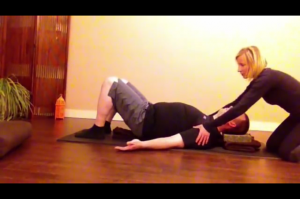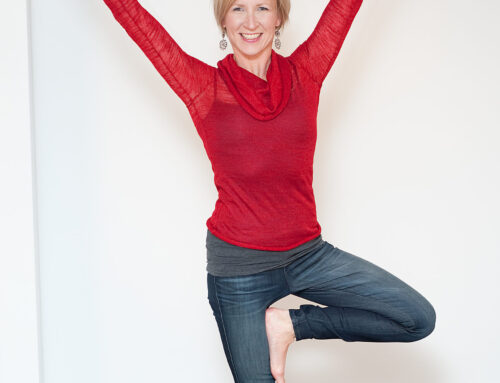Yoga for Ankylosing Spondylitis
Shelly Prosko, PT, C-IAYT
I recently had a physical therapist colleague ask me for advice about some ‘yoga poses’ that may help her client who has ankylosing spondylitis (AS). I explained that there are certainly some poses I would share with her that could potentially address some of the ‘general’ commonalities of the symptoms of AS and how people with AS may present in similar ways, but I also explained I thought it was important for her and her client to understand that:
1) therapeutic yoga is so much more than prescribing ‘poses’ for a particular dysfunction or special population
and
2) the statement, “yoga for ankylosing spondylitis” (or any diagnosis) tends to suggest (in my opinion) that we are using a reductionist approach and falling into the trap of treating/addressing a diagnosis instead of a person who is a living, breathing, moving, thinking, feeling and reacting being that is connected to and affected by the surrounding environment. A being that consists of complex systems and layers: each one influencing the other; including the nervous systems, digestive system, musculoskeletal system, hormonal system, immune system, integumentary system, emotional, social and spiritual layers, just to name a few.
That being said, there are certainly some common physiotherapy exercises + yoga methods that can be used for people looking to optimize spinal and rib mobility and alignment, maximize breath pattern, improve pain management, and/or calm the nervous system. But I suppose that would be a really long title for this article.
I can appreciate how it’s easier to simply say “Yoga For ( diagnosis )”; and I would assume we all understand that we’re making generalizations that aren’t to be used as prescription or individual therapy, but simply outlining some potentially valuable guidelines in order to help people.
I don’t believe these types of titles we (including me) continuously use for our workshops, webinars, books, videos, etc are accurate titles for what we as yoga therapists offer our clients. I’m trying to be more creative and honest with my titles; I hope my colleagues in this industry will do the same. I think it’s important to be clear.
So, for the record, this article is not meant to be interpreted as ‘Yoga for Ankylosing Spondylitis’. I just want to be clear that I strongly believe in ‘Yoga For the Individual Person’ and his or her unique physical, mental, emotional, energetic, & spiritual state, which is constantly changing and responding.
Keeping this in mind, I’d like to share the response to my colleague’s request!
One of my yoga students, who happens to also have AS, was willing to be a ‘model’ to demonstrate some ‘physio + yoga’ techniques that I chose for this case. A short interview with him is also included at the end of the VIDEO about how yoga has helped him manage his symptoms of AS. I hope you enjoy the video and find something valuable and perhaps even worth sharing with someone you think may benefit:
For those readers who may not know about AS, it is a chronic inflammation of the joints of the spine and considered to be an autoimmune disease. For reasons we do not know (although, there is speculation and theories presented) the body receives a ‘trigger’ that tells it to ‘attack’ itself. The body can potentially then go into ‘repair’ mode, causing excess bone formation which explains the fusion of joints that is sometimes seen in advanced AS.
Some of the symptoms and complications of AS that have been documented are as follows:
-pain experienced in the areas of SI joint, spine, hips, shoulders, knees, ankles
-stiffness/reduced mobility of spine
-reduced chest/rib mobility or expansion, resulting in decreased efficient breathing patterns
-fatigue
-inflammation
-osteopenia/osteoporosis
-digestion problems (IBS)
Some of the intentions of PhysioYoga therapy in this case are to:
-reduce the chances or severity of secondary complications as above
-help improve management of symptoms as above
-maintain and optimize joint mobility
-optimize muscle health and function
-maximize efficient breathing patterns (which can help us move better and improve energy and sleep)
-maximize gastro-intestinal health
-improve our physiological stress response (calm/balance the nervous systems)
-improve self management of pain
-increase self-efficacy
-optimize feelings of joy, pleasure and gratitude
-maximize functional capacity and quality of life
Certain yoga poses, movements and breathing methods can help address posture and mobility as well as potentially address the energetic layer (address fatigue, improve sleep) or produce a calming effect on the nervous system which can help with such things as pain management.
Mindfulness or meditation practises such as awareness, visualization or other methods of focus can also potentially help with pain management, change the pain experience, and perhaps even reduce the chance that the genes associated with inflammation are expressed (Kaliman et al, 2014). Yoga for Healthy Aging BlogSpot contributor, Ram Rao, has some great articles that shed more light on this topic: “Chronic Inflammation and Yoga” & “Meditation: Effects on Gene Expression”
There is currently no formal test to actually diagnose AS. The Arthritis Society states that although most people that have AS carry the HLA-B27 gene; that most people with the HLA-B27 gene do not get AS. So, just because you have the gene, doesn’t mean you will get AS. The Arthritis Society states: “in fact, only a very small number of people with this gene will ever develop AS.”
If your physician suspects you have AS, it is a good idea to get a referral to a rheumatologist to help guide and manage your care.
PhysioYoga can be used as a valuable and beneficial complementary therapy to one’s current medical treatment. I highly recommend following and continuing with your medical treatment plan, in addition to finding a physical therapist or health care professional in your area that is trained in integrating yoga therapy and nutritional therapy into his or her treatment sessions.
Or perhaps a yoga therapist or teacher in your community can work together with your physical therapist and health care team for optimal success and safety.
With education, supportive treatment as needed, and guidance, people with AS can have active, meaningful, happy lives and relationships filled with vitality and longevity.
**This article and video is not meant to diagnose, treat or act as medical advice. Please consult your health care provider for clearance and guidance before following or participating in these activities**





